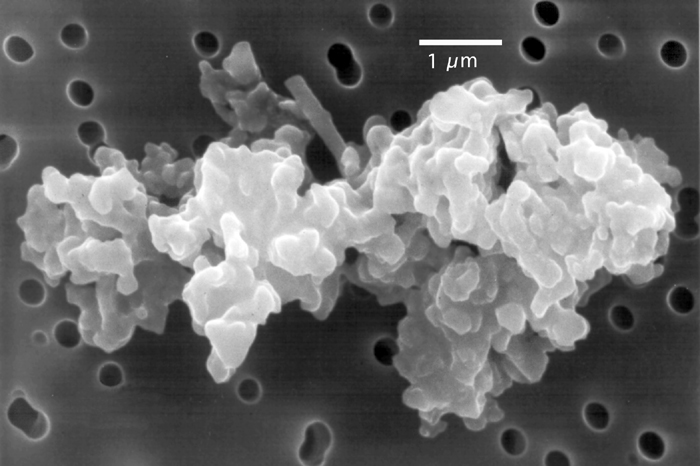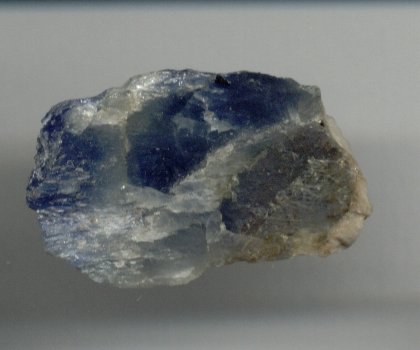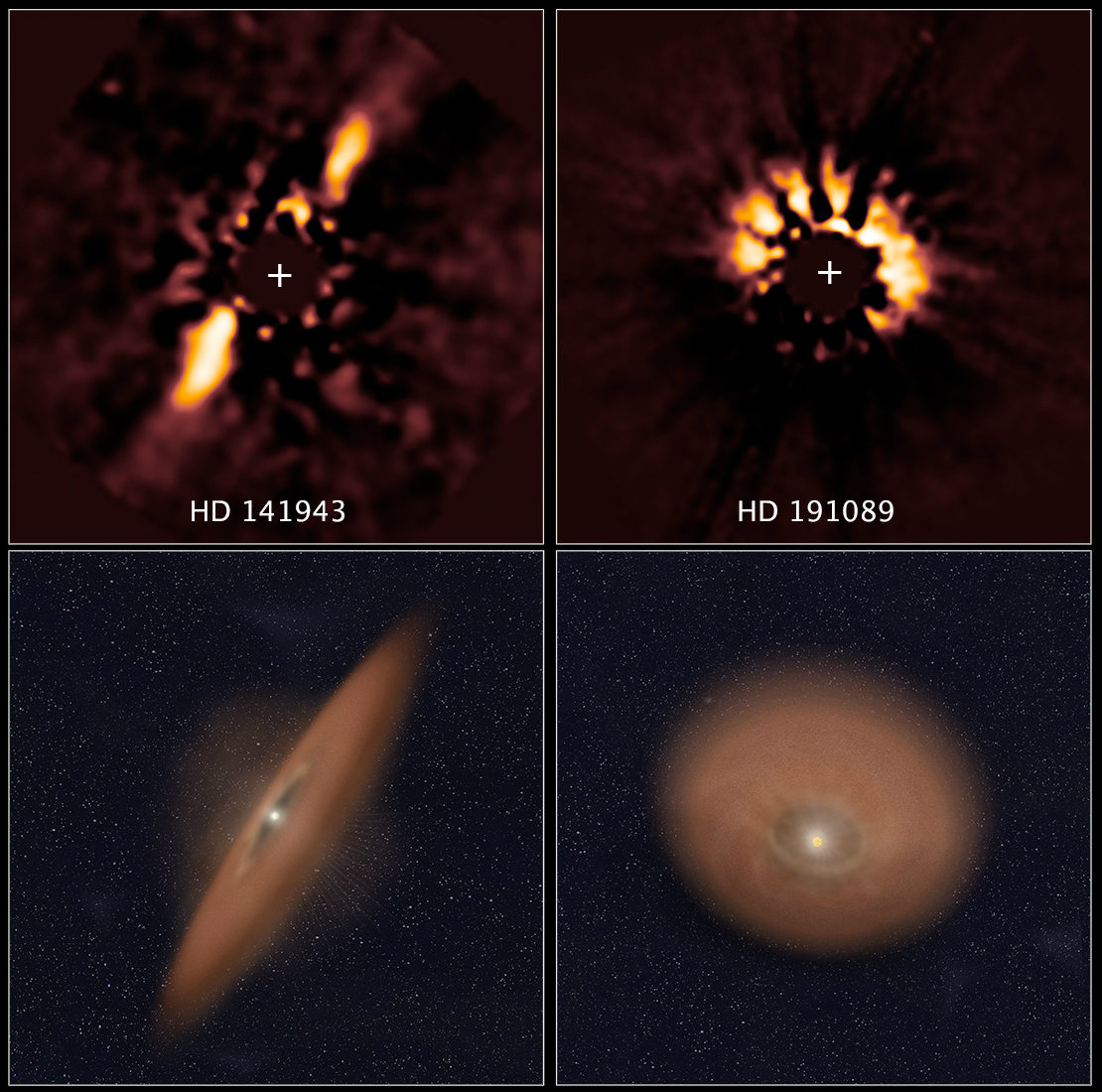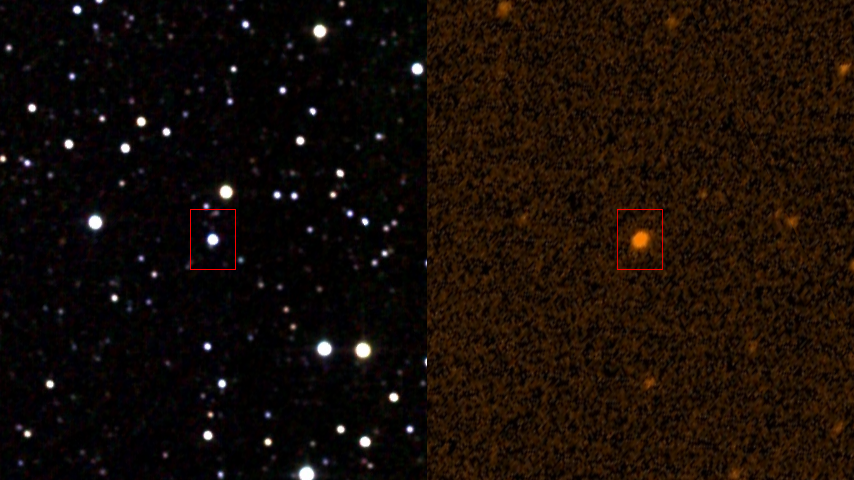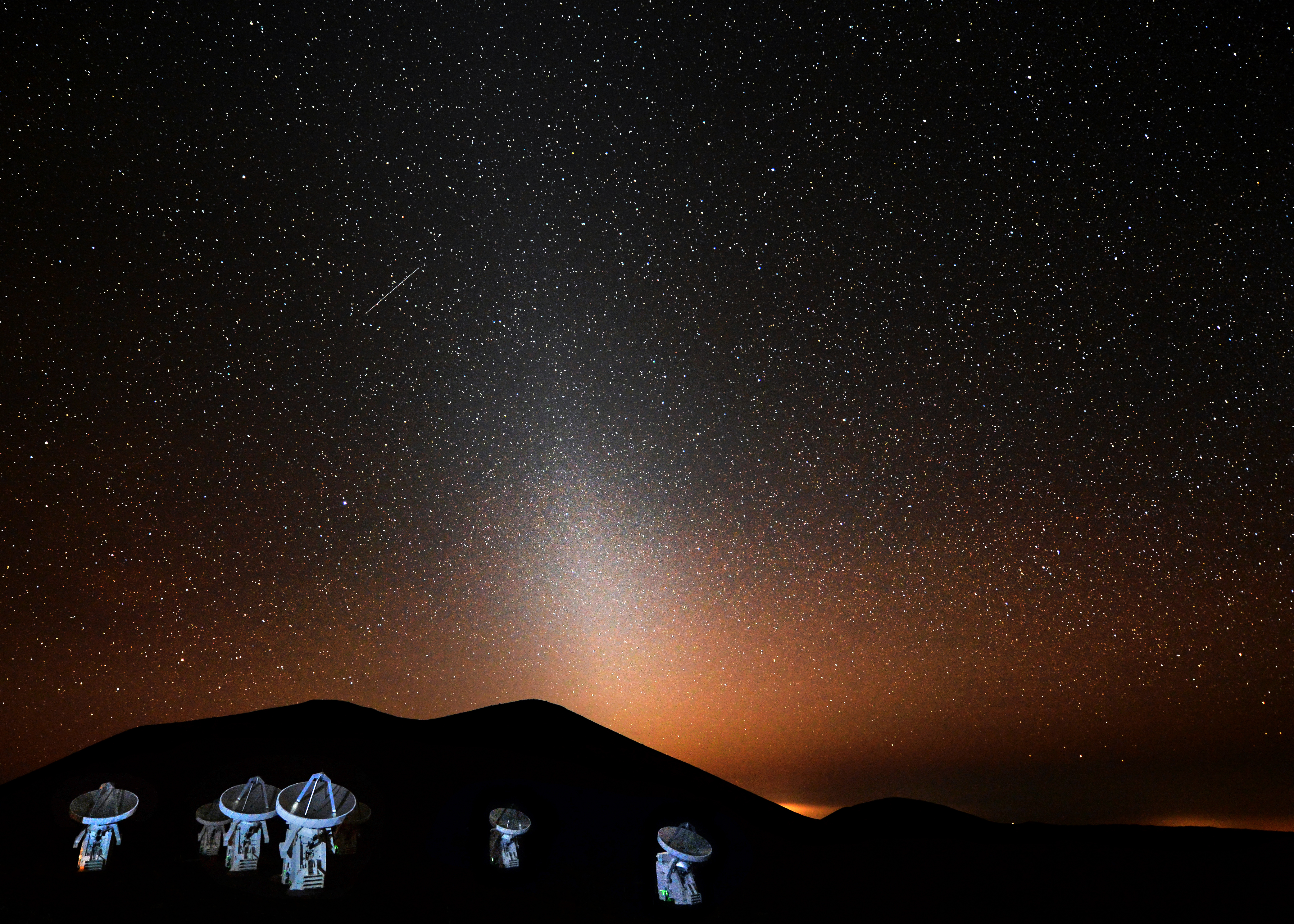|
Circumstellar Dust
Circumstellar dust is cosmic dust around a star. It can be in the form of a spherical shell or a disc, e.g. an accretion disk. Circumstellar dust can be responsible for significant extinction and is usually the source of an infrared excess for stars that have it. For some evolved stars on the asymptotic giant branch, the dust can be composed of silicate emissions. According to a study, it is still uncertain whether the dust is a result of crystalline silicate or polycyclic aromatic hydrocarbon. However, recent observations revealed that Vega-type stars display broad silicate emission. It is suggested that the circumstellar dust components can depend on the evolutionary stage of a star and is related to the changes in its physical conditions. The study of the composition of this dust is dubbed astrominerology. The circumstellar dust around aging stars has been observed to include, "almost pure crystalline Mg-rich silicates (forsterite and clinoenstatite), amorphous silicates, diop ... [...More Info...] [...Related Items...] OR: [Wikipedia] [Google] [Baidu] |
Cosmic Dust
Cosmic dustalso called extraterrestrial dust, space dust, or star dustis dust that occurs in outer space or has fallen onto Earth. Most cosmic dust particles measure between a few molecules and , such as micrometeoroids (30 μm). Cosmic dust can be further distinguished by its astronomical location: intergalactic dust, interstellar dust, interplanetary dust (as in the zodiacal cloud), and circumplanetary dust (as in a planetary ring). There are several methods to obtain space dust measurement. In the Solar System, interplanetary dust causes the zodiacal light. Solar System dust includes comet dust, planetary dust (like from Mars), asteroidal dust, dust from the Kuiper belt, and interstellar dust passing through the Solar System. Thousands of tons of cosmic dust are estimated to reach Earth's surface every year, with most grains having a mass between 10−16 kg (0.1 pg) and 10−4 kg (0.1 g). The density of the dust cloud through which the Earth is traveling is approximately ... [...More Info...] [...Related Items...] OR: [Wikipedia] [Google] [Baidu] |
Corundum
Corundum is a crystalline form of aluminium oxide () typically containing traces of iron, titanium, vanadium, and chromium. It is a rock (geology), rock-forming mineral. It is a naturally transparency and translucency, transparent material, but can have different colors depending on the presence of transition metal impurities in its crystalline structure. Corundum has two primary gemstone, gem varieties: ruby and sapphire. Rubies are red due to the presence of chromium, and sapphires exhibit a range of colors depending on what transition metal is present. A rare type of sapphire, Sapphire#Padparadscha, padparadscha sapphire, is pink-orange. The name "corundum" is derived from the Tamil language, Tamil-Dravidian languages, Dravidian word ''kurundam'' (ruby-sapphire) (appearing in Sanskrit as ''kuruvinda''). Because of corundum's hardness (pure corundum is defined to have 9.0 on the Mohs scale), it can scratch almost all other minerals. Emery (rock), Emery, a variety of corundum w ... [...More Info...] [...Related Items...] OR: [Wikipedia] [Google] [Baidu] |
Stellar Astronomy
Astronomy is a natural science that studies astronomical object, celestial objects and the phenomena that occur in the cosmos. It uses mathematics, physics, and chemistry in order to explain their origin and their overall chronology of the Universe, evolution. Objects of interest include planets, natural satellite, moons, stars, nebulae, galaxy, galaxies, meteoroids, asteroids, and comets. Relevant phenomena include supernova explosions, gamma ray bursts, quasars, blazars, pulsars, and cosmic microwave background radiation. More generally, astronomy studies everything that originates beyond atmosphere of Earth, Earth's atmosphere. Cosmology is a branch of astronomy that studies the universe as a whole. Astronomy is one of the oldest natural sciences. The early civilizations in recorded history made methodical observations of the night sky. These include the Egyptian astronomy, Egyptians, Babylonian astronomy, Babylonians, Greek astronomy, Greeks, Indian astronomy, Indians, Ch ... [...More Info...] [...Related Items...] OR: [Wikipedia] [Google] [Baidu] |
Planetesimal
Planetesimals () are solid objects thought to exist in protoplanetary disks and debris disks. Believed to have formed in the Solar System about 4.6 billion years ago, they aid study of its formation. Formation A widely accepted theory of planet formation, the planetesimal hypothesis of Viktor Safronov, states that planets form from cosmic dust grains that collide and stick to form ever-larger bodies. Once a body reaches around a kilometer in size, its constituent grains can attract each other directly through mutual gravity, enormously aiding further growth into moon-sized protoplanets. Smaller bodies must instead rely on Brownian motion or turbulence to cause the collisions leading to sticking. The mechanics of collisions and mechanisms of sticking are intricate. Alternatively, planetesimals may form in a very dense layer of dust grains that undergoes a collective gravitational instability in the mid-plane of a protoplanetary disk—or via the concentration and gravitatio ... [...More Info...] [...Related Items...] OR: [Wikipedia] [Google] [Baidu] |
WD 1145+017
WD 1145+017 (also known as EPIC 201563164) is a white dwarf approximately from Earth in the constellation of Virgo. It is the first white dwarf to be observed with a transiting minor planet orbiting it. Stellar characteristics The white dwarf has a mass of 0.6 , radius of 0.012 (1.34 ) and a temperature of 15,020 K, typical for white dwarf stars. It has been a white dwarf for 224 million years. The star's spectrum includes strong absorption lines due to magnesium, aluminium, silicon, calcium, iron and nickel. These elements commonly found in rocky planets are polluting the surface of the star, and would normally be expected to mix through the star and disappear from view after a million years. A circumstellar dust cloud and disk (likely due to disintegrating asteroids, located at 97 to 103 R_wd, and emitting thermal IR radiation) surrounds the star. In addition, a circumstellar gas disk (located ~ 25 to 40 R_wd, and undergoing relativistic precession with a period ... [...More Info...] [...Related Items...] OR: [Wikipedia] [Google] [Baidu] |
List Of Stars That Have Unusual Dimming Periods
A list is a set of discrete items of information collected and set forth in some format for utility, entertainment, or other purposes. A list may be memorialized in any number of ways, including existing only in the mind of the list-maker, but lists are frequently written down on paper, or maintained electronically. Lists are "most frequently a tool", and "one does not ''read'' but only ''uses'' a list: one looks up the relevant information in it, but usually does not need to deal with it as a whole". Lucie Doležalová,The Potential and Limitations of Studying Lists, in Lucie Doležalová, ed., ''The Charm of a List: From the Sumerians to Computerised Data Processing'' (2009). Purpose It has been observed that, with a few exceptions, "the scholarship on lists remains fragmented". David Wallechinsky, a co-author of '' The Book of Lists'', described the attraction of lists as being "because we live in an era of overstimulation, especially in terms of information, and lists help ... [...More Info...] [...Related Items...] OR: [Wikipedia] [Google] [Baidu] |
Tabby's Star
Tabby's Star (designated as KIC 8462852 in the Kepler Input Catalog and also known by the names Boyajian's Star and WTF (Where'sTheFlux?) Star, is a binary star in the constellation Cygnus approximately from Earth. The system is composed of an F-type main-sequence star and a red dwarf companion. Unusual light fluctuations of Tabby's Star, including up to a 22% dimming in brightness, were discovered by citizen scientists as part of the Planet Hunters project. The discovery was made from data collected by the Kepler space telescope, which observed changes in the brightness of distant stars to detect exoplanets. Several hypotheses have been proposed to explain the star's large irregular changes in brightness, but , none of them fully explain all aspects of the resulting light curve. It has been suggested that it is an alien megastructure, but evidence tends to discount this suggestion. In September 2019, astronomers reported that the observed dimmings of Tabby's Star ... [...More Info...] [...Related Items...] OR: [Wikipedia] [Google] [Baidu] |
Circumplanetary Disk
A circumplanetary disk (or circumplanetary disc, short CPD) is a torus, pancake or ring-shaped accumulation of matter composed of gas, dust, planetesimals, asteroids or collision fragments in orbit around a planet. They are reservoirs of material out of which moons (or exomoons or subsatellites) may form. Such a disk can manifest itself in various ways. In August 2018, astronomers reported the probable detection of a circumplanetary disk around CS Cha B. The authors state that "The CS Cha system is the only system in which a circumplanetary disc is likely present as well as a resolved circumstellar disc." In 2020 though, the parameters of CS Cha B were revised, making it an accreting red dwarf star, and making the disk circumstellar. Theory A giant planet will mainly form via core accretion. In this scenario a core forms via the accretion of small solids. Once the core is massive enough it might carve a gap onto the circumstellar disk around the host star. Material w ... [...More Info...] [...Related Items...] OR: [Wikipedia] [Google] [Baidu] |
Accretion Disc
An accretion disk is a structure (often a circumstellar disk) formed by diffuse material in orbital motion around a massive central body. The central body is most frequently a star. Friction, uneven irradiance, magnetohydrodynamic effects, and other forces induce instabilities causing orbiting material in the disk to spiral inward toward the central body. Gravitational and frictional forces compress and raise the temperature of the material, causing the emission of electromagnetic radiation. The frequency range of that radiation depends on the central object's mass. Accretion disks of young stars and protostars radiate in the infrared; those around neutron stars and black holes in the X-ray part of the spectrum. The study of oscillation modes in accretion disks is referred to as diskoseismology. Manifestations Accretion disks are a ubiquitous phenomenon in astrophysics; active galactic nuclei, protoplanetary disks, and gamma ray bursts all involve accretion disks. These disks ... [...More Info...] [...Related Items...] OR: [Wikipedia] [Google] [Baidu] |
Zodiacal Light
The zodiacal light (also called false dawn when seen before sunrise) is a faint glow of diffuse sunlight scattered by interplanetary dust. Brighter around the Sun, it appears in a particularly dark night sky to extend from the Sun's direction in a roughly triangular shape along the zodiac, and appears with less intensity and visibility along the whole ecliptic as the zodiacal band. Zodiacal light spans the entire sky and contributes to the natural light of a clear and moonless night sky. A related phenomenon is ''gegenschein'' (or ''counterglow''), sunlight backscattered from the interplanetary dust, which appears directly opposite to the Sun as a faint but slightly brighter oval glow. Zodiacal light contributes to the natural light of the sky, though since zodiacal light is very faint, it is often outshone and rendered invisible by moonlight or light pollution. The interplanetary dust in the Solar System forms a thick, pancake-shaped cloud called the zodiacal cloud wh ... [...More Info...] [...Related Items...] OR: [Wikipedia] [Google] [Baidu] |
Solar System
The Solar SystemCapitalization of the name varies. The International Astronomical Union, the authoritative body regarding astronomical nomenclature, specifies capitalizing the names of all individual astronomical objects but uses mixed "Solar System" and "solar system" structures in theinaming guidelines document. The name is commonly rendered in lower case ('solar system'), as, for example, in the ''Oxford English Dictionary'' an''Merriam-Webster's 11th Collegiate Dictionary''. is the gravitationally bound Planetary system, system of the Sun and the objects that orbit it. It Formation and evolution of the Solar System, formed about 4.6 billion years ago when a dense region of a molecular cloud collapsed, forming the Sun and a protoplanetary disc. The Sun is a typical star that maintains a hydrostatic equilibrium, balanced equilibrium by the thermonuclear fusion, fusion of hydrogen into helium at its stellar core, core, releasing this energy from its outer photosphere. As ... [...More Info...] [...Related Items...] OR: [Wikipedia] [Google] [Baidu] |
Radiation Pressure
Radiation pressure (also known as light pressure) is mechanical pressure exerted upon a surface due to the exchange of momentum between the object and the electromagnetic field. This includes the momentum of light or electromagnetic radiation of any wavelength that is Absorption (electromagnetic radiation), absorbed, Reflection (physics), reflected, or otherwise emitted (e.g. black-body radiation) by matter on any scale (from macroscopic objects to dust particles to gas molecules). The associated force is called the radiation pressure force, or sometimes just the force of light. The forces generated by radiation pressure are generally too small to be noticed under everyday circumstances; however, they are important in some physical processes and technologies. This particularly includes objects in outer space, where it is usually the main force acting on objects besides gravity, and where the net effect of a tiny force may have a large cumulative effect over long periods of time. ... [...More Info...] [...Related Items...] OR: [Wikipedia] [Google] [Baidu] |
